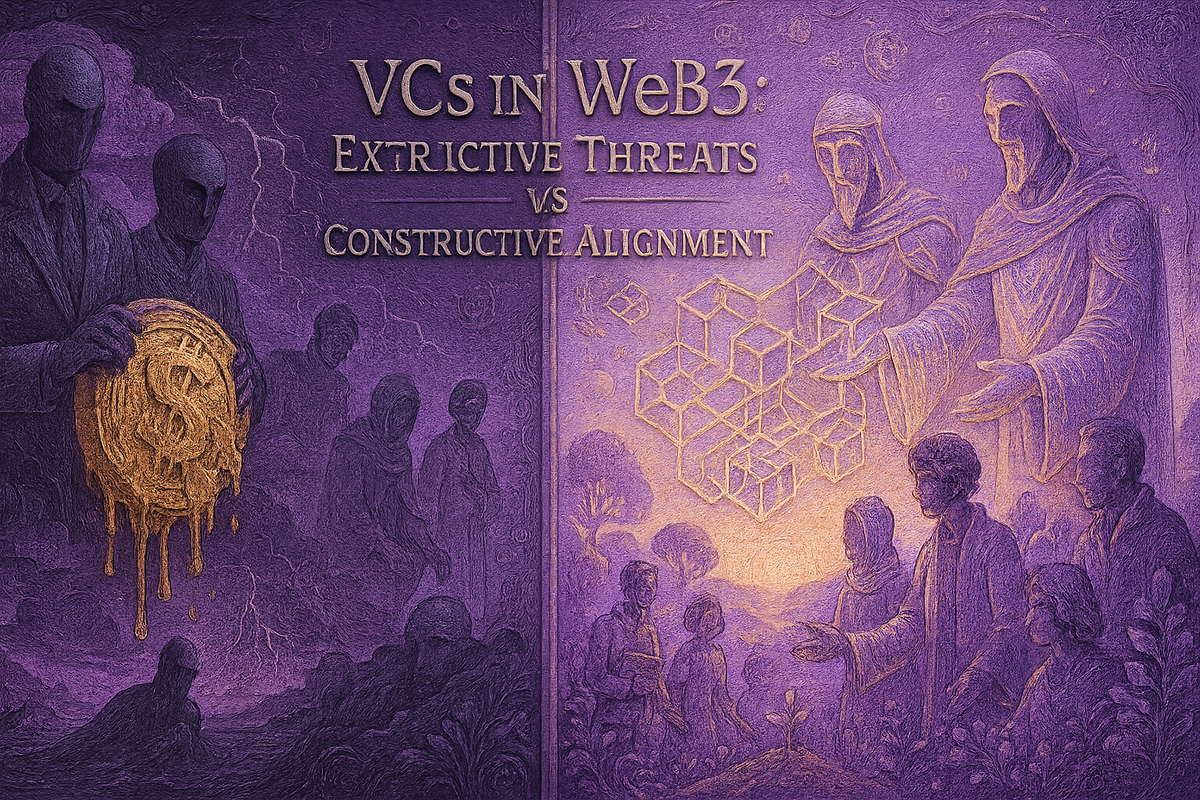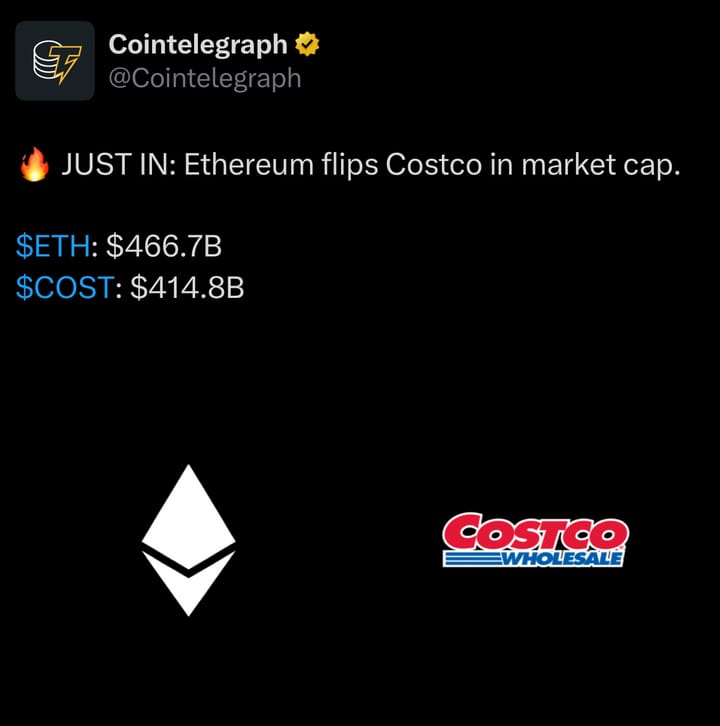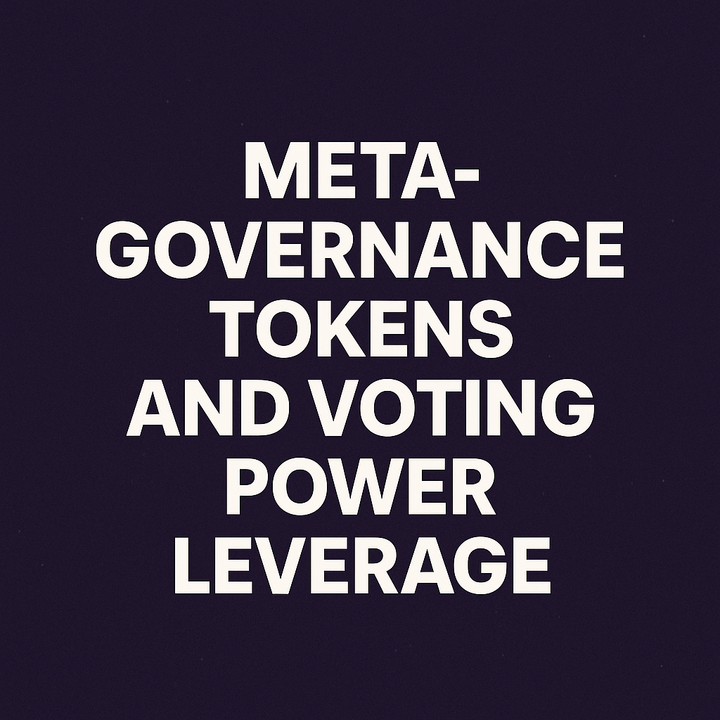VCs in Web3: Extractive Threats vs Constructive Alignment

Abstract
This article digs into the key, but controversial role of venture capital (VC) in Web3, a decentralized digital space pushing for user ownership and openness. It breaks down how VC can both drive innovation and cause friction because of centralized control and profit motives. Using real-world examples, financial stats, and new funding ideas, the piece emphasizes that VC funding must match Web3’s core values to keep growth healthy and trust strong.
VCs in Web3 – Ideological and Practical Tensions
Web3’s promise of decentralization clashes at times with the traditional venture capital (VC) model. Advocates argue that VCs provide essential early capital, credibility, and expertise to help blockchain startups grow faster (cryptorank). Indeed, VC backing often brings mentorship, partnerships, and professional networks that bootstrap projects beyond what grassroots funding can achieve. Critics counter that heavy VC involvement can undermine decentralization, leading to concentrated control, inflated valuations, and misaligned interests. Ideologically, purists point out that Bitcoin and even Ethereum launched without VC money, relying on community funding – they worry that Web3 “decentralization” is being co-opted by wealthy investors. In practice, founders must balance the upside of VC resources against the downside of potential loss of autonomy and community trust. As one analysis summarized, venture capital in crypto is a double-edged sword: it “helps projects grow and secure credibility” even as it can introduce “centralized control” and conflicts with the community ethos (cryptorank). This tension defines much of the debate around Web3 VCs.
The Dual Narrative: Catalyst or Villain?
The role of VC in Web3 sparks heated debate, in-fact they are bitterly hated. Some (including myself) see VCs as essential for scaling innovation, while critics argue they centralize power and prioritize short-term gains. This section demistify these perspectives and their underlying tensions.
Prevailing Perceptions of VC in Web3
Web3’s ethos of “giving power back to the masses” conflicts with VC’s centralized capital pools and influence (VentureCrowd). Even beneficial VC actions face scrutiny, as projects labeled “VC-backed” struggle to gain community trust due to fears of centralized control. Bitcoin and Ethereum’s community-funded origins fuel purist skepticism, with concerns that VCs co-opt decentralization (Cointelegraph Magazine). This tension reflects a broader ideological clash between Web3’s vision and VC’s traditional model.
Arguments for VC Involvement
VCs provide critical resources for Web3’s capital-intensive growth, offering “always on capital” and flexible fundraising through tokenized markets (Alpaca). They promote financial inclusion, lower market entry barriers, and support community-led projects, driving economic growth. VCs also enhance portfolio diversification and develop reward systems, while their expertise in user experience and regulatory navigation helps projects like Coinbase and Aave attract Web2 users (Alpaca, Mitosis). Firms like a16z and Paradigm act as ecosystem builders, bridging innovation with commercial viability (Growth Equity Interview Guide).
The Constructive Role of VCs in Advancing Web3
Despite controversies, venture capital has undeniably accelerated the development of the Web3 ecosystem. In the 2010s, dedicated crypto funds (like a16z Crypto, Polychain, Paradigm) emerged and poured money into foundational infrastructure – from Layer-1 blockchains to exchanges – at a time when few other funding sources existed. VC investment gives projects access to seed capital to build out critical infrastructure that might never materialize via small community grants (cryptorank).
For example, Solana and Ripple each secured early VC backing that allowed them to scale rapidly (Solana was funded by firms like Andreessen Horowitz and Polychain, and Ripple by IDG Capital) (cryptorank). Beyond cash, top VCs offer mentorship and expertise in navigating complex regulatory and technical hurdles (cryptorank). Polkadot’s development benefited from VC guidance (8 Decimal Capital helped Polkadot forge key partnerships), and Coinbase leveraged Andreessen Horowitz’s help on compliance and expansion strategy during its rise (cryptorank). VCs also open doors via their partnership networks – for instance, backing from Blockchain Capital and Standard Crypto helped Aave connect with Polygon to launch on that network (cryptorank). Likewise, Union Square Ventures’ support of CryptoKitties (Dapper Labs) led to influential gaming industry partnerships (cryptorank). VC endorsement further confers validation and credibility, attracting other investors and users. When Andreessen Horowitz invested in Uniswap’s decentralized exchange, it signaled Uniswap’s potential and helped spur wider adoption (the value of UNI tokens and liquidity on the platform surged following a16z’s backing) (cryptorank). Across the board, VC funding has accelerated growth: with deep pockets, startups can hire top talent and iterate faster on product development.
Analytics firm Chainalysis doubled revenue year-over-year after raising from Accel and Benchmark, and developer platform Alchemy scaled to support 70% of top Web3 apps following investments by Pantera and Coinbase Ventures (cryptorank). In short, VCs have played a constructive role in Web3 by financing core infrastructure, recruiting talent, shaping industry narratives (through research and media influence), and even supporting early-stage R&D. Notably, some prominent crypto VCs demonstrate long-term commitment: for example, Fred Wilson’s firm USV and others kept Dapper Labs (creator of CryptoKitties) alive through the 2018–19 bear market when the company was near collapse – funding that allowed Dapper to later launch the Flow blockchain and NBA Top Shot (avc comavc). In that case, the VCs’ patience paid off and even benefited the community (Dapper sold Flow tokens to the public at the same price that early VCs paid, ensuring fairness) (avc.com). Such cases underscore how aligned venture investment can help build enduring Web3 value.
Why Many in Web3 Are Skeptical of Venture Capital
Despite the benefits, there is deep skepticism toward VCs in many crypto communities. A chief complaint is the pattern of early “token dumps” – venture investors buying cheap in private rounds and then cashing out as soon as lockups expire, leaving retail holders with slumping prices. It’s common for VCs to receive large token allocations at a fraction of public price, subject to 6–24 month lockups; when those unlock, the “dilemma” emerges: dump for a massive profit (often tanking the token’s market price) or hold longer (cointelegraph). Typically, VCs are perceived to choose the former (cointelegraph), Indeed, crypto VC firms have faced backlash for dumping tokens en masse after the token generation event – the launch of Internet Computer (ICP) in 2021 is a notorious example, where heavy VC selling coincided with a >90% collapse in ICP’s price shortly after release (cryptorank). Such incidents foster mistrust that VCs are just using communities as exit liquidity.
There’s also a sense of misaligned incentives between VCs and grassroots participants. VCs, accountable to their LPs, typically seek outsized returns on a 5–7 year timeline, whereas crypto communities prioritize long-term utility and gradual decentralization. This misalignment often becomes stark post-token-launch: one report notes community anger erupting on crypto Twitter when airdrop token allocations were perceived as “unfair due to VC interests” – e.g. controversies in 2024 over Polyhedra Network and zkSync token distributions favoring insiders (cryptorank). Ideologically, many argue that VC dominance undermines decentralization.
Large early stakes give VCs outsized voting power in “community” governance, leading to whale-controlled protocols. Critics highlight “whale governance” and insider allocations as fundamentally at odds with Web3’s ethos (mitosis). Even founders fear loss of control: taking VC money can mean ceding board seats or token supply that erodes the project’s autonomy. Case studies like Tezos (2018), where a fight erupted between the founders and a VC-backed foundation, illustrate how governance can turn acrimonious (cryptorank). Furthermore, some argue VCs can distort project trajectories by chasing hype.
A risk analyst recounting the Terra/Luna collapse noted that big-name crypto funds on Luna’s cap table (Pantera, Three Arrows, etc.) created a false sense of security – “VC backers must be seeing something you don’t” – even though the algorithmic stablecoin model was deeply flawed (cointelegraph). In hindsight, Luna was a Ponzi that imploded spectacularly, yet its VC backing had lent it credibility it didn’t deserve. Such examples fuel the perception that some VCs will promote and exit unsustainable projects, leaving retail holding the bag. Centralization concerns, short-termism, and trust issues thus drive much of the anti-VC sentiment in Web3 communities (mitosis). As one crypto founder put it, “The only ‘scaling’ in Web3 is the VCs’ exit speed – they can now exit in 3–6 months instead of 5–10 years”, reflecting cynicism that VCs are just in it for quick profit.
The Celestia–Polychain Fallout as a VC Exit Gone Wrong
The incident involving Celestia's TIA token and Polychain Capital serves as a stark illustration of the tensions arising from VC exit strategies and their impact on community trust and token economics. Polychain Capital, an early investor in Celestia, held a significant stake of over 43 million TIA tokens. Their intention to sell these tokens on the open market presented a substantial risk of destabilizing the token's price and undermining confidence among retail investors.
In response, the Celestia Foundation intervened, purchasing Polychain's entire remaining stake for $62.5 million. While this move prevented an immediate "dump," the Foundation's plan to redistribute these tokens to new investors through a phased unlock schedule (between August and November) was perceived by some as merely delaying the inevitable "sell pressure," leading to a "slow-motion dump loading". This event highlighted the inherent conflict when early investors, having realized significant profits, seek to liquidate their holdings, potentially at the expense of the broader community's long-term interests. (Unchained Crypto).
VC Investment in Crypto: Scale and Evolving Trends
Venture capital investment in crypto/Web3 has grown from a niche trickle into a flood (with some recent ebbing), reaching tens of billions of dollars in total. Cumulatively, over $80–100 billion of VC money has flowed into crypto startups and protocols over the past decade, with the majority of that coming during the 2021–2022 boom years (theblockbeats). Annual fundraising data tells the story of a hype cycle: In 2020, blockchain startups raised a modest ~$3.5 billion – similar to 2019’s level (theblockbeats). But in 2021, VC investment in crypto soared to roughly $33 billion, the largest year on record (theblockbeats). This was about 10X higher than just two years prior, reflecting a frenzy of interest as concepts like DeFi, NFTs, and “Web3” entered the mainstream. 2021 alone saw over 2,000 crypto deals (double the count of 2020), and more than 65 new crypto unicorns were minted (theblockbeats). By late 2021, crypto accounted for ~4.7% of all venture capital investment globally (theblockbeats) – a remarkable share for a once-esoteric sector. The 2021 funding peak was marked by mega-deals like FTX’s $900M round (July 2021) at an $18B valuation (theblockbeats), and an influx of non-crypto firms (Sequoia, Tiger Global, Goldman Sachs, etc.) joining the party (theblockbeats).
2022 kept pace initially – total crypto VC funding for the year ended up over $30 billion (roughly on par with 2021) (theblockbeats) – but the trend reversed mid-year. Investment “peaked in the first half” of 2022 and then fell sharply in Q3 and Q4 (theblockbeats) as the crypto market entered a downturn and high-profile failures (Terra, FTX) shook confidence. In fact, Q4 2022 saw the lowest crypto funding quarterly total since early 2021 (theblockbeats). Still, by raw numbers 2022 slightly exceeded 2021’s record with ~$33+ billion deployed (the “best year ever” by that metric) (theblockbeats), owing to the strong first-half momentum. The pullback became fully apparent in 2023: crypto venture investment collapsed to roughly one-third of the prior year. Only around ~$10–12 billion was invested globally in 2023, and each quarter of 2023 saw new lows in deal count and capital as the “crypto winter” persisted. Late-stage mega-deals vanished, and investors shifted to much more cautious valuations. By 2023, early-stage rounds dominated the activity (pre-seed and seed deals forming a majority of deals, though even those saw smaller check sizes on average)(theblockbeats).
2024 showed signs of stabilization and a slight rebound. According to industry data, crypto VC funding ticked up ~28% year-over-year in 2024 to about $13–14 billion (still far below the 2021–22 peak) (galaxy). The number of new crypto funds launched also bottomed out and began to rise gradually again in late 2024 (galaxy). In early 2025, momentum has tentatively improved – Q1 2025 saw a few large infusions, including a massive $2 billion strategic investment into Binance that made that quarter one of the biggest since 2022 (galaxy). Even excluding that one-off deal, Q1 2025’s venture tally suggested the sector is on pace to exceed 2024’s total if trends continue (galaxy). However, investor interest is now far more selective, and some venture dry powder has pivoted to hotter areas like AI, meaning crypto funding, while recovering, remains below its frothy peak (galaxy).
Alongside these volume swings, the focus of funding has rotated across subsectors. In the 2016–2018 ICO era, much investment was retail-driven, but by 2019–2020 VCs were mostly funding exchanges, wallets, and financial infrastructure (theblockbeats) (infotheblockbeats). By 2021’s bull run, a huge portion of VC dollars went into centralized financial intermediaries and trading platforms (over $13.8B, ~42% of 2021’s total, went to exchanges, brokerages, and lending companies (theblockbeats). At the same time, “Web3” consumer and metaverse plays (NFT platforms, gaming, DAO tooling, etc.) emerged as a new category, accounting for about 17% of 2021 funding (theblockbeats). DeFi protocols and Layer-1/L2 infrastructure also received significant investment, though often via token sales rather than traditional equity. In 2022, data shows Web3/gaming startups actually led by number of deals (lots of small seed investments), but the bulk of capital still went into trading platforms and late-stage companies raising big rounds (theblockbeats). The crash of late 2022 and 2023 then saw a flight to quality and core tech: VCs shifted toward backing infrastructure (e.g. Ethereum Layer-2 networks, interop protocols) and away from frothier NFT/entertainment projects (theblockbeats). By 2023, the largest funding recipients were crypto exchanges and brokerages (reflecting a few big bailouts or expansion rounds), followed by Layer-2 and interoperability projects, with consumer Web3 and metaverse startups falling behind in capital share (theblockbeats). This trend continued into 2024–2025: recent analysis shows that DeFi and infrastructure projects have overtaken NFTs/gaming in attracting VC dollars, which have now slipped to fourth place in terms of capital allocation (galaxy). (Interestingly, the Web3/NFT sector still leads in number of deals – lots of teams are building – but these deals are smaller on average (galaxy) In short, after the speculative frenzy for NFTs and tokens in 2021, investor interest rotated back to the “picks and shovels” of crypto: scaling solutions, developer tools, payments, and institutional platforms. The narrative focus has likewise evolved – e.g. 2023–2025 saw VC hype around modular blockchains (splitting execution, consensus, and data layers) as the next big thing, spurring new funds and incubators targeting that modular ecosystem. Overall, the data illustrates a maturing sector: huge VC inflows in the peak years, a sobering contraction, and now a recalibration toward more foundational building blocks in the Web3 stack.
Historical Trends
Table 1: Web3 VC Investment Trends Over Time
Year/Period | Total Capital Invested ($B) | Number of Deals | Key Funding Categories | Noteworthy Trends/Context |
|---|---|---|---|---|
2021 | $33 | ~2,000 | DeFi, NFTs, intermediaries | Bull market, mega-deals |
2022 | $30 | >3,500 | Broad across sectors | Peak then decline in Q3–Q4 |
2023 | $10–12 | N/A | N/A | 67% drop, innovation bottleneck |
2024 | $13–14 | ~220 (gaming) | Stablecoins, DeFi, AI x Crypto, modular blockchains | 28% increase, early-stage surge |
Q1 2025 | $4.8 | 446 | Trading/Exchange, DeFi, Infrastructure | Strongest quarter since 2022, Binance deal skew |
Recalibrating Capital in Web3: Toward Constructive Alignment
Venture capital in Web3 occupies a wide spectrum from aligned, long-term partners to short-term extractors. The future of sustainable crypto ecosystems lies in strengthening the former while checking the latter.
Constructive vs. Extractive Capital
Constructive capital supports ecosystem growth and project resilience:
- Infrastructure Investment: VCs backing Solana, Polkadot, and Celestia helped advance scalable blockchain infrastructure (Bit2Me, Mitosis).
- Multi-Stage Support: Paradigm and a16z’s long-term investment in Coinbase and Uniswap nurtured sustained growth.
- Utility-Driven Models: Funds like Qubit Capital emphasize adoption and real-world use cases.
- Ecosystem Building: Accelerators and early-stage programs foster talent and tooling.
In contrast, extractive capital undermines trust and tokenomics:
- Early Exits: Polychain’s $240M TIA sell-off and the ICP crash post-launch epitomize VC short-termism.
- Misaligned Incentives: VC-driven speculation, such as in Terra/Luna, amplified risk and collapse (Rainmaker).
- Centralization Risks: Large VC holdings distort governance and decision-making (Frontiers).
- Hype-Driven Funding: Misallocated capital led to the failure of immature consumer-facing Web3 apps (Outlier Ventures).
Alignment Models in Practice
1. Transparent Vesting Mechanisms
Token vesting locks allocations, releasing them gradually like stock options to ensure long-term alignment. Projects such as Celestia enforced this rigorously—its 2025 Lotus upgrade ensured staking rewards were locked along with principal allocations, closing critical loopholes (Meegle, Colony Blog).
“The only thing holding VCs to [their] schedule is on-chain vesting.” – Cointelegraph
2. VCs in Governance
Rather than passive stakeholders, constructive VCs are increasingly acting as protocol stewards. Andreessen Horowitz, for instance, participates openly in DAO governance, aligning investor influence with community interests (Airbyte).
3. Alternative Funding Mechanisms
Web3 communities are building capital pathways independent of traditional VC models:
- Gitcoin Grants: Over $45M allocated to Ethereum-based public goods like Uniswap by 2022 (Gitcoin).
- RetroPGF (Retroactive Public Goods Funding): Used by Optimism to reward proven contributions (HackMD).
- DAOs-as-Funders: Groups like MolochDAO and The LAO democratize funding, though scaling remains a challenge.
- Builder DAOs: In 2025, Cardano’s Builder DAO began allocating grants based on on-chain dApp performance, empowering developers with capital control.
Funding Model | Speed | Community Alignment | Scalability | Examples |
|---|---|---|---|---|
VC | Fast | Low-Medium | High | Uniswap, Coinbase |
Gitcoin Grants | Medium | High | Medium | Uniswap early grants |
RetroPGF | Slow | High | Low-Medium | Optimism-funded tools |
DAOs-as-Funders | Slow | High | Low | MolochDAO, Cardano Builder DAO |
Table 2: Comparing VC and Alternative Funding Models
Conclusion: The Path Forward for VC in Web3
Web3’s relationship with capital is evolving. While traditional VCs remain essential for early-stage growth, the industry is embracing models that enhance accountability, transparency, and shared upside. The next phase VC 2.0 is more than just about funding; it’s about staying power, participation, and alignment with the open, decentralized ethos of blockchain. The most durable projects will be those where builders, users, and investors grow together—not at each other’s expense.
The story of venture capital in Web3 is still being written. Ideally, it is trending toward a partnership model where value is created and captured by all stakeholders in unison.
References
- Airbyte, https://airbyte.com/data-engineering-resources/data-owner-vs-data-steward
- Alpaca, https://alpaca.vc/2023/10/field-study-alpacas-thesis-on-web3-ventures-most-controversial-space/
- AVC, https://avc.com/2022/03/the-benefits-of-venture-capital-in-web3/
- Bit2Me, https://news.bit2me.com/en/abstract-is-launched-powered-by-zksync-and-celestia
- Blockchain Council, https://www.blockchain-council.org/cryptocurrency/top-5-blockchain-security-issues/
- Chainalysis, https://www.chainalysis.com/blog/2025-crypto-crime-mid-year-update/
- Cointelegraph Magazine, https://cointelegraph.com/magazine/risks-benefits-venture-capital-funds-crypto-communities/
- Colony Blog, https://blog.colony.io/understanding-token-vesting/
- Celestia Foundation Acquires Polychain's $62 Million in TIA Stake - Unchained Crypto, https://unchainedcrypto.com/celestia-foundation-acquires-polychains-62-million-in-tia-stake/
- Frontiers, https://www.frontiersin.org/journals/blockchain/articles/10.3389/fbloc.2021.730122/full
- Galaxy, https://www.galaxy.com/insights/research/crypto-venture-capital-q1-2025
- [GITCOIN 3.0] https://gov.gitcoin.co/t/gitcoin-3-0-gitcoin-grants-3-0-strategy-sprint/20384
- Dependency Funding - HackMD, https://hackmd.io/@gh0stwheel/BkaAU8KKT?utm_source=preview-mode&utm_medium=rec
- Meegle, https://www.meegle.com/en_us/topics/web3/token-vesting-schedules
- Mitosis, https://university.mitosis.org/the-role-of-venture-capitalists-in-the-rise-of-web3-successes-failures-and-lessons-learned/
- Outlier Ventures, https://outlierventures.io/article/everything-you-know-about-web3-fundraising-is-wrong-the-truth-behind-consumer-vs-infra-narrative-in-web3/
- Rainmaker, https://medium.com/rainmaker-citizen/the-web3-incentive-model-thats-killing-your-platform-2ef9d3e57b80
- Unchained Crypto, https://unchainedcrypto.com/celestia-foundation-acquires-polychains-62-million-in-tia-stake/
- VentureCrowd, https://venturecrowd.my.site.com/s/learn/invest/5-reasons-investors-web3



Comments ()